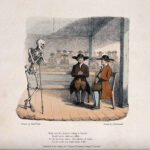22 October 1674: Barbara Lee dies and – says her epitaph – is then buried upright under the fireplace of St James’ Church, Norton, Sheffield
Sidney Oldall Addy. 1888. A Glossary of Words Used in the Neighbourhood of Sheffield. London: English Dialect Society/Trübner and Co. Get it:
.Excerpt
In puncto perpendiculari hujusce superficei mortalis pars Barbaræ uxoris Iohannis Lee filiæque Iohannis Lees generosi de East Retford continetur quæ non tam ætate quam virtute clara hujusce mundi fruitionem deseruit vicesimo secundo die Octobris anno domini 1674 ætatis suæ 28. Prima sui breviter gracilis pars defluit ævi, Iuxta distillans, igne premente, liquor.
It appears from this remarkable epitaph that the body of this poor woman was buried in a perpendicular hole in the place where the high altar once stood, there being probably no room to lay the coffin in the usual position. The words of the couplet which concludes the epitaph are obscure, but I take them to mean that Mrs Barbara Lee, who seems to have been the wife of the parish clerk, was buried under or near to the fireplace, which was then built upon the site of the altar. There is something ghastly in the idea of the body melting or “swealing” away from the heat of the fire above it. The desire to be buried in the church long survived the Reformation, and the neighbourhood of the altar was the favourite resting-place. In old York wills the desire is sometimes expressed to be buried with the face turned towards the altar, or with the feet touching the feet of the priest who celebrated mass.
Comment
Comment
Having discovered this I may stop asking Quakers whether Mrs Taylor’s upright burial at Brighouse was theological.
Something to say? Get in touch
Original
When Norton Church was ‘restored’ in the year 1882, I copied the following inscription from a stone which lay under the altar or communion table adjoining the east window:
In puncto perpendiculari hujusce superficei mortalis pars Barbaræ uxoris Iohannis Lee filiæque Iohannis Lees generosi de East Retford continetur quæ non tam ætate quam virtute clara hujusce mundi fruitionem deseruit vicesimo secundo die Octobris anno domini 1674 ætatis suæ 28.
Prima sui breviter gracilis pars defluit ævi,
Iuxta distillans, igne premente, liquor.
It appears from this remarkable epitaph that the body of this poor woman was buried in a perpendicular hole in the place where the high altar once stood, there being probably no room to lay the coffin in the usual position. The words of the couplet which concludes the epitaph are obscure, but I take them to mean that Mrs. Barbara Lee, who seems to have been the wife of the parish clerk,* was buried under or near to the fireplace, which was then built upon the site of the altar. There is something ghastly in the idea of the body melting or ‘swealing’ away from the heat of the fire above it. The epitaph, which is copied correctly, can have no other meaning. The body stands upright, with the fireplace over the head. The desire to be buried in the church long survived the Reformation, and the neighbourhood of the altar was the favourite resting-place. In old York wills the desire is sometimes expressed to be buried with the face turned towards the altar, or with the feet touching the feet of the priest who celebrated mass.
278 words.
Similar
 31 October 1684: Mrs Taylor of Brighouse, a Quaker, is buried upright next to her husband and daughter in their garden
31 October 1684: Mrs Taylor of Brighouse, a Quaker, is buried upright next to her husband and daughter in their garden 5 March 1829: Henry Burton of Hotham tells a rowdy public meeting at Beverley to petition parliament against Catholic emancipation and preserve “the Protestant constitution”
5 March 1829: Henry Burton of Hotham tells a rowdy public meeting at Beverley to petition parliament against Catholic emancipation and preserve “the Protestant constitution”Search
Donate
Music & books
Place-People-Play: Childcare (and the Kazookestra) on the Headingley/Weetwood borders next to Meanwood Park.
Music from and about Yorkshire by Leeds's Singing Organ-Grinder.


 Bluesky
Bluesky Extwitter
Extwitter